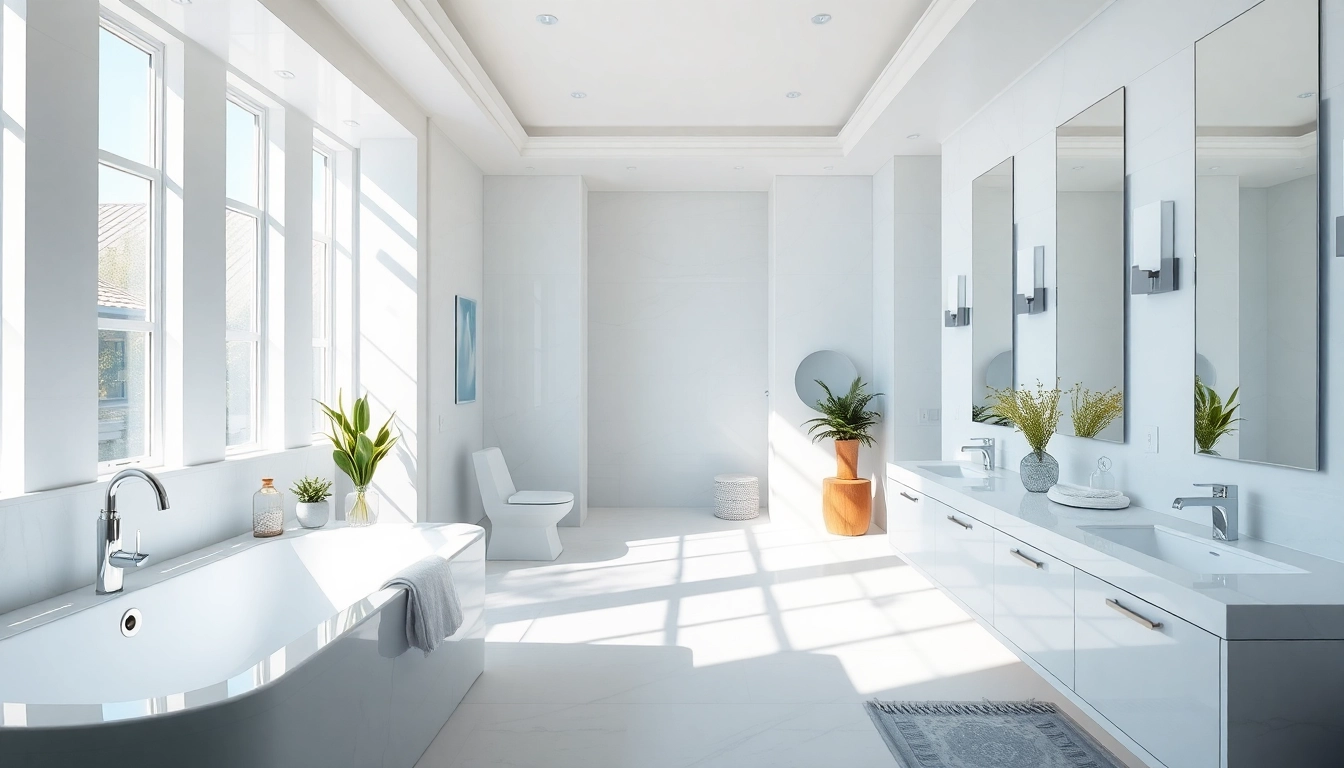Understanding Your Kitchen Remodel Needs
Undertaking a kitchen remodel is an exciting yet daunting project for many homeowners. A remodel can range from minor cosmetic changes to a complete overhaul of the kitchen space. Before diving into the specifics, it’s essential to understand your kitchen remodel needs to design a space that aligns with your lifestyle and aesthetic preferences. By clarifying these needs, you can streamline the project and create a functional, beautiful kitchen that serves as the heart of your home. To kick off your journey, consider consulting resources available for a comprehensive kitchen remodel.
Defining Your Style and Functionality
Before you start tearing down walls or picking out cabinetry, it’s vital to define your style and functionality requirements. Your kitchen should reflect your personal style while also serving its primary function as a cooking and gathering space. Consider the following:
- Style: Do you prefer a traditional feel with rich woods and detailed cabinetry, or are you drawn to modern aesthetics with sleek lines and minimalistic designs?
- Functionality: How do you use your kitchen daily? If cooking is your primary focus, you might need a layout that prioritizes space for appliances, prep areas, and storage.
- Flow: The layout should accommodate easy movement between work zones. The classic work triangle (the distance between the sink, stove, and refrigerator) should guide your space planning.
Setting a Realistic Budget for Your Project
Your kitchen remodel budget will largely dictate the scope of your project. Setting a realistic budget involves several considerations:
- Determine your priorities: List what’s most important to you—whether it’s high-end appliances, custom cabinetry, or flooring.
- Understand average costs: Research the average costs for kitchen remodels in your region. On average, homeowners can expect to pay between $32,000 and $77,000 for a medium to large kitchen remodel, depending on materials and labor.
- Include a buffer: It’s wise to set aside at least 10-15% of your budget for unexpected expenses that may arise during the renovation process.
Evaluating the Current Kitchen Layout
A careful evaluation of your existing kitchen layout can highlight aspects that work and those that don’t. Consider the following steps:
- Assess the current workflow: How easy is it to move between food preparation, cooking, and cleaning? Are there steps that disrupt this flow?
- Identify problem areas: Look for bottlenecks, inadequate storage, or appliances that are difficult to access.
- Gather inspiration: Collect ideas from magazines, websites, or home improvement shows to visualize how to improve your space.
Essential Steps for Planning Your Kitchen Remodel
With a clear understanding of your needs, it’s time to focus on the essential steps for planning your kitchen remodel. This stage integrates the practical aspects of design and execution, ensuring a holistic approach to your renovation.
Design Considerations for Optimal Space Utilization
Designing a kitchen involves strategic planning to optimize space. Consider these design elements:
- Open-concept designs: An open layout can create a more inviting environment and allows for multitasking, especially for families.
- Island installations: A kitchen island can serve multiple purposes, such as extra counter space, storage, or a breakfast bar.
- Vertical storage solutions: Utilize vertical space with tall cabinets or open shelving to maximize storage without overwhelming your floor plan.
Choosing the Right Materials and Finishes
The materials and finishes you select will significantly impact your kitchen’s overall look and functionality. Here is a guide to making your choices:
- Countertops: Granite, quartz, and butcher block are popular materials, each with unique care requirements and price points. Choose one that fits your culinary habits and maintenance preferences.
- Cabinetry: Decide between custom, semi-custom, and stock cabinetry options. Both functionality and aesthetic appeal play a role in this decision.
- Flooring: Tile, hardwood, and vinyl are all viable choices. Consider durability and ease of cleaning to ensure longevity in a high-traffic area.
Keeping an Eye on Trends in Kitchen Remodeling
Staying updated with current trends will not only keep your kitchen looking fresh but will also help in enhancing its value. Some popular trends include:
- Smart kitchens: Integrating technology and smart appliances can offer convenience and energy efficiency.
- Bold colors: While neutral palettes dominate, splashes of color through cabinetry, backsplashes, or islands can create a striking contrast.
- Eco-friendly materials: Sustainable practices and recycled materials are becoming increasingly important to homeowners who want to minimize their ecological footprint.
Hiring Professionals for Your Kitchen Remodel
While some homeowners may choose to tackle a remodel independently, enlisting professionals can streamline the process and deliver higher-quality results. Here’s how to navigate hiring experts for your project.
Finding the Right Contractor for Your Vision
Choosing the right contractor is crucial to achieving your vision. Start with these steps:
- Do your research: Look for contractors with strong portfolios, good reviews, and relevant experience in kitchen remodels.
- Ask for recommendations: Friends, family, or real estate agents can provide valuable referrals for reputable contractors.
- Interview potential candidates: Engage in conversations about their vision for your project and gauge their communication skills and willingness to collaborate.
Understanding Design Services and Fees
Professional design services can help bring your kitchen vision to life, but it’s important to understand the associated costs. Here’s what to consider:
- Design fees vary: Some designers charge a flat fee, while others may take a percentage of the overall project cost.
- Included services: Ensure you know what services are included—such as layout planning, material selection, and project management—to avoid unexpected costs.
- Potential ROI: Investing in a professional designer can yield higher returns on your investment and prevent costly mistakes.
Collaborating Efficiently for Best Results
Collaboration with your contractor and designer is key to a smooth renovation process:
- Establish clear communication: Discuss project timelines, budget constraints, and design preferences upfront.
- Regular check-ins: Schedule frequent meetings to address concerns and ensure the project stays on course.
- Flexibility: Be open to suggestions from your team, as their expertise may offer valuable insights that enhance the final result.
Budgeting for Your Kitchen Remodel Project
A well-planned budget is central to a successful kitchen remodel. Let’s delve into the budgeting process.
Typical Costs and What to Expect
Understanding the typical costs associated with a kitchen remodel is crucial for financial planning. Here are key cost breakdowns:
- Cabinets: This can account for 30-40% of your total budget, depending on the materials and customization level.
- Appliances: Set a budget from $4,000 to $10,000 or more, depending on whether you opt for standard or high-end appliances.
- Countertops: Expect to spend between $50 to $150 per square foot for materials, impacting total costs based on your kitchen size.
Budgeting for Unexpected Expenses
Kitchen remodels can frequently reveal hidden issues that may require additional funds:
- Hidden damages: Issues like plumbing leaks or electrical problems can increase costs unexpectedly.
- Changes in scope: Mid-project changes can disrupt timelines and budgets, so proceed carefully if you consider any modifications.
- Contingency fund: Budget for unexpected surprises by allocating 10-15% of your overall budget towards unforeseen expenses.
Financing Options for Your Remodel
If your budget does not cover all expenses, various financing options can support your kitchen remodel:
- Home equity loans: These allow you to borrow against the equity in your home, often offering lower interest rates than other loans.
- Personal loans: Unsecured loans can cover renovation costs but may carry higher interest rates and repayment terms.
- Government renovation programs: Look for local or federal programs that may offer financial assistance or grants for remodels.
Post-Remodel: Enjoying Your New Kitchen Space
After the dust settles and your kitchen remodel is complete, it’s time to enjoy your new space. Here are ways to make the most of your remodeled kitchen:
Maintenance Tips for Longevity and Beauty
To keep your kitchen sparkling and functional, regular maintenance is key:
- Daily cleaning: Wipe down surfaces and appliances to prevent grime and buildup.
- Regular inspections: Assess plumbing and electrical installations periodically to catch issues early.
- Professional upkeep: Schedule annual maintenance for appliances and fixtures to ensure longevity.
Maximizing the Use of Your New Kitchen
With your remodel complete, consider these tips to maximize your kitchen’s functionality:
- Organize like items: Store kitchen items categorically (e.g., pots with pans, spices with cooking oils) to streamline cooking.
- Incorporate multi-functional elements: Use islands or carts for both food prep and casual dining, enhancing your kitchen’s utility.
- Host gatherings: Use your new space to entertain, allowing friends and family to enjoy the heart of your home.
Inspiring Ideas for Decorating After Your Remodel
Lastly, enhance the aesthetic appeal of your kitchen with thoughtful decoration:
- Artwork and signage: Personalize your space with art that reflects your style or vintage kitchen signs for a homely feel.
- Functional decor: Arrange cookbooks or beautiful kitchen tools as decorative yet practical items.
- Seasonal touches: Add decorative elements for different seasons—like fresh flowers or autumnal colors—to keep the ambiance lively.















Leave a Reply